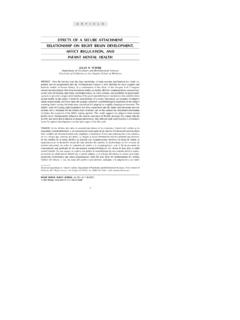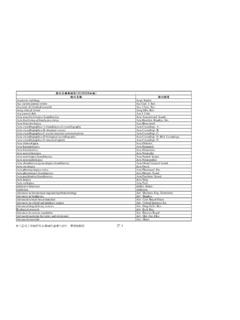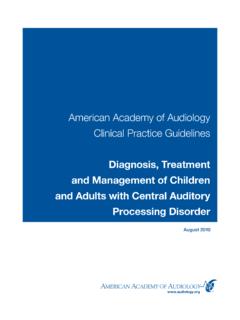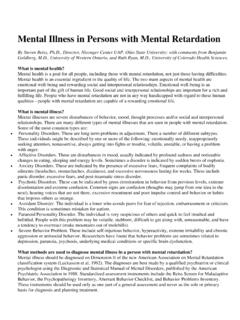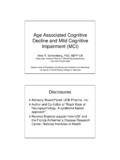Transcription of Attachment and the regulation of the right brain
1 Attachment and the regulationof the right brain *A L L A N N . S C HO R EABSTRACTIt has been three decades since John Bowlby rst presented anover-arching model of early human development in his groundbreakingvolume, Attachment . In the present paper I refer back to Bowlby s originalcharting of the Attachment landscape in order to suggest that current researchand clinical models need to return to the integration of the psychological andbiological underpinnings of the theory. Towards that end, recent contributionsfrom neuroscience are offered to support Bowlby s assertions that attachmentis instinctive behavior with a biological function, that emotional processes lieat the foundation of a model of instinctive behavior, and that a biologicalcontrol system in the brain regulates affectively driven instinctive control system can now be identi ed as the orbitofrontal system and itscortical and subcortical connections.
2 This senior executive of the emotionalbrain acts as a regulatory system, and is expanded in the right hemisphere,which is dominant in human infancy and centrally involved in theory is essentially a regulatory theory, and Attachment can bede ned as the interactive regulation of biological synchronicity betweenorganisms. This model suggests that future directions of Attachment researchshould focus upon the early-forming psychoneurobiological mechanisms thatmediate both adaptive and maladaptive regulatory processes. Such studies willhave direct applications to the creation of more effective preventive andtreatment WORDS: affective processes Attachment theory orbitofrontal system psychobiological regulation right hemisphereIn 1969, which was 29 years after his initial publication of an article in theInternational Journal of Psycho-Analysison how the early environmentcould in uence the development of character (1940), John Bowlby integratedhis career-spanning observations and theoretical conceptualizations into the rst of three in uential books on Attachment and loss.
3 This foundationalvolume, Attachment , was groundbreaking for a number of reasons. It focusedupon one of the major questions of science: speci cally, how and why docertain early ontogenetic events have such an inordinate effect on everythingAttachment & Human Development Vol 2 No 1 April 200023 47 Correspondence to: Allan N. Schore, 9817 Sylvia Avenue, Northridge, CA 91324, USA.*An abbreviated version of this article appeared as a Foreword to Basic Book s reprinting ofJohn Bowlby s classic volume & Human DevelopmentISSN 1461-6734 print/1469-2988 online 2000 Taylor & Francis TT A C HME NT& HU MA ND E V E L OP ME NTV OL. 2 NO. 124that follows? Bowlby s scienti cally-informed curiosity about this questionenvisioned the center stage of human infancy, on which is played the rstchapter of the human drama, to be a context in which a mother and her infantexperience connections and disconnections of their vital emotional com-munications.
4 Bowlby presented his model in such a way that both a heuris-tic theoretical perspective and a testable experimental methodology could becreated to observe, measure, and evaluate certain very speci c mechanismsby which the early social environment interacts with the maturing organismin order to shape developmental processes (Schore, 2000).But perhaps of even more profound signi cance was his carefully arguedproposition that an interdisciplinary perspective should be applied to thestudy of developmental phenomena as they exist in nature. In such anapproach the collaborative knowledge-bases of a spectrum of sciences wouldyield the most powerful models of both the nature of the fundamental onto-genetic processes that mediate the infant s rst Attachment to another humanbeing, and the essential psychobiological mechanisms by which these pro-cesses indelibly in uence the development of the organism at later points ofthe response to this classic volume Ainsworth observed that In effectwhat Bowlby has attempted is to update psychoanalytic theory in the lightof recent advances in biology (1967, p.)
5 998). Bowlby s deep insights intothe potential synergistic effects of combining the literatures of whatappeared on the surface to be distantly related realms may now seem like abrilliant flash of intuition. In actuality it represented a natural convergenceof his two most important intellectual influences, Charles Darwin andSigmund Freud. In order to create a perspective that could describe criticalevents both in the external and in the internal world, concepts from bothethology (behavioral biology) and psychoanalysis are presented and inter-woven throughout the volume. In essence, a central goal of Bowlby s firstbook is to demonstrate that a mutually enriching dialogue can be organizedbetween the biological and the psychological realms, something attemptedby Darwin (1872) in the first scientific treatise on the biology and psy-chology of emotion, The Expression of Emotions in Man and Animals, andby Freud (1895) in his endeavor to integrate neurobiology and psychologyin order to create a natural science , Project for a Scientific Psychology(Schore, 1997a).
6 Although both Darwin and Freud emphasized the centrality of earlydevelopment as an important part of their overall work, each primarilyfocused his observational and theoretical lens on the adaptive and maladap-tive functioning of fully matured adult organisms. In the AttachmentvolumeBowlby (1969) argues that clinical observers and experimental scientistsshould intensively focus on the developing organisms that are in the processof maturing. More speci cally, he calls for deeper explorations of the funda-mental ontogenetic mechanisms by which an immature organism is criticallyshaped by its primordial relationship with a mature adult member of itsspecies, that is, more extensive studies of how an Attachment bond formsbetween the infant and the mother. In this conception, Bowlby asserts thatthese developmental processes are the product of the interaction of a uniquegenetic endowment with a particular environment, and that the infant semerging social, psychological, and biological capacities cannot be under-stood apart from its relationship with the mother.
7 B O WL B Y S O R I G I N A L C H A RTI N G S O F T H EATTAC H ME NT L A N D S C A P EMuch has transpired since the original publication of Bowlby s Attachment ,and the ensuing explosion of Attachment research over the last quarter of acentury is a testament to the power of the concepts it contains. And yet a (re-) reading of this classic still continues to reveal more and more subtleinsights into the nature of developmental processes, and to shine light uponyet to be fully explored areas of developmental research. In fact, in thisseminal work of developmental science, the pioneering Bowlby presents asurvey of what he sees to be the essential topographic landmarks of theuncharted territory of mother infant relationally driven psychobiologicalprocesses. The essential guideposts of this dynamic domain the centralphenomena that must be considered in any overarching model of how theattachment relationship generates both immediate and long-enduring effectson the developing individual are presented by Bowlby in not only thesubject-matter but also the structural organization of the book.
8 The readerwill notice that the book is divided into four parts, The task , Instinctivebehaviour , Attachment behaviour and Ontogeny of human Attachment ,and that Bowlby devotes ten chapters to the rst two parts, and seven to thelast two is now more than 30 years since Bowlby s call for a far-reaching pro-gramme of research into the social responses of man, from the preverbalperiod of infancy onwards (p. 174). In the following, I want to brie y offer,from a psychoneurobiological perspective, not only my views of the originalcontents of Bowlby s guidebook, but also some thoughts about the currentand future directions of the experimental and clinical explorations of attach-ment theory as they pass from one century into the next. In doing so, I willspeci cally attend to not so much the quality of Attachment research, whichhas served as a standard in psychology, psychiatry, and psychoanalysis as awhole, or to the breadth of the research, which spans developmental psy-chology, developmental psychobiology, developmental neurochemistry,infant psychiatry, and psychoanalysis, but rather to the foci of currentinvestigations, as measured against the original prescriptions that are offeredhere by Bowlby.
9 And I will suggest that certain uninvestigated areas of thisattachment domain, sketched out in Bowlby s cartographic descriptions inthis book, are now ready to be explored by interdisciplinary researchSC HOR E: A TT A C HME NTA NDT HER I G HTB R A I N25programs. For a broad overview of the eld at the end of century I refer thereader to two excellent edited volumes, Attachment theory: Social, develop-mental, and clinical perspectives(Goldberg, Muir & Kerr, 1995) and Hand-book of Attachment : Theory, research, and clinical applications (Cassidy &Shaver, 1999).In the book most current readers are very familiar (or even perhaps onlyfamiliar) with the latter two sections on Attachment , and most researcherscontinue to focus their investigation upon the concepts outlined in these laterchapters. It is here, as well as in the introductory sections, that Bowlby pre-sents his essential contributions on the infant s sequential responses to separ-ation from the primary Attachment gure protest, despair, and the context of emphasizing the importance of studying the infant s behav-ior speci cally during the temporal interval when the mother returns,Bowlby introduces the recent methodology of Ainsworth, which will soonbecome the major experimental paradigm for Attachment research, the incre-mentally stress-increasing strange situation.
10 But in addition to theorizing on the nature of separation responses, stress-ful ruptures of the mother infant bond, Bowlby also describes what he seesas the fundamental dynamics of the Attachment relationship. In stating thatthe infant is active in seeking interaction, that the mother s maternal behav-ior is reciprocal to the infant s Attachment behavior, and that the develop-ment of Attachment is related both to the sensitivity of the mother inresponding to her baby s cues and to the amount and nature of their inter-action, he lays a groundwork that presents Attachment dynamics as a recip-rocal interchange (p. 346), a conceptualization that is perfectly compatiblewith recent advances in dynamic systems theory (Schore, 1997b, in press a;Lewis, 1995, 1999, in press).At the very beginning of the section on Attachment behavior Bowlbyoffers his earliest model of the essential characteristics of Attachment it isinstinctive social behavior with a biological function, readily activatedespecially by the mother s departure or by anything frightening, and thestimuli that most ef ciently terminate the systems are sound, sight, or touchof the mother , and is a product of the activity of a number of behaviouralsystems that have proximity to mother as a predictable outcome (p.)

